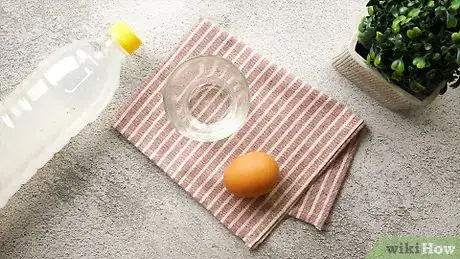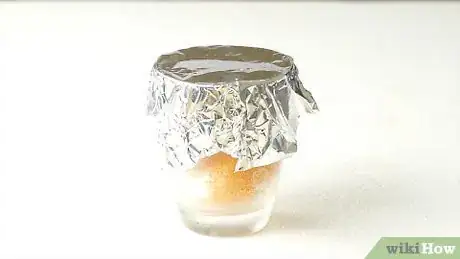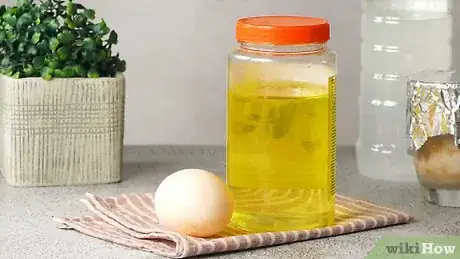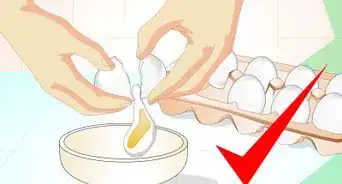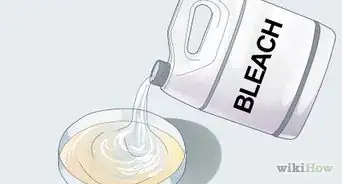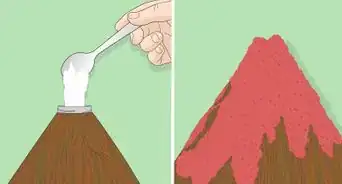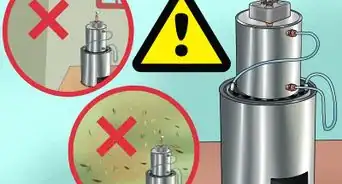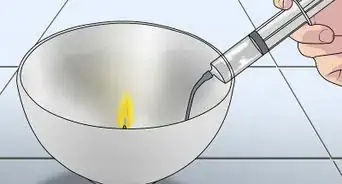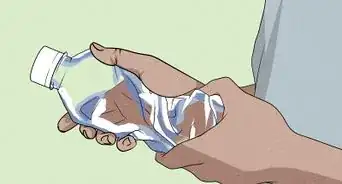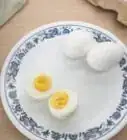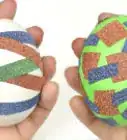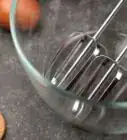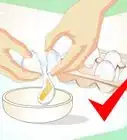This article was co-authored by Bess Ruff, MA. Bess Ruff is a Geography PhD student at Florida State University. She received her MA in Environmental Science and Management from the University of California, Santa Barbara in 2016. She has conducted survey work for marine spatial planning projects in the Caribbean and provided research support as a graduate fellow for the Sustainable Fisheries Group.
This article has been viewed 111,359 times.
You can dissolve the shell of an egg so that the membrane is completely intact, leaving the egg “naked.” The process is simple, takes only a few days, and can easily be done using household objects. An eggshell is made up mostly of a compound called calcium carbonate which dissolves when exposed to an acid such as vinegar.[1] During the chemical reaction, you will see tiny bubbles of carbon dioxide be released from the surface of the egg. This is an easy and safe science experiment to perform at home.
Steps
Dissolving the Eggshell
-
1Gather your materials. For this experiment you will need a fresh, uncooked egg, a drinking glass, a dissolving solution such as white vinegar or a cola beverage, and 4-5 days of patience. The drinking glass needs to be large enough for the egg to touch the bottom without touching the sides of the glass.[2]
- You can also use a plastic cup or container to hold the egg, but clear containers allow you to observe the experiment over time.
- Use a fresh egg because an older egg will float in the liquid.
- Before you begin, examine your uncooked egg for cracks.
-
2Place the egg in the glass and submerge with vinegar. Gently place the egg in the bottom of the glass taking care not to crack it. Pour enough vinegar (or cola) over the egg until it is completely submerged in the liquid.[3]
- The chemical reaction between the acetic acid in the cola and the calcium carbonate in the eggshell causes the shell to dissolve.
Advertisement -
3Cover and refrigerate the egg for 24 hours.[4] Cover the top of the container with foil or plastic wrap and place it on a shelf of the refrigerator where it will remain undisturbed. Keep it out of the way so it doesn't get knocked around.
-
4Replace the vinegar in the cup after 24 hours. After the first day, you should see the frothy residue of the shell on the surface of the liquid. You will also see that parts of the shell still remain on the egg. The shell takes at least 2 days to fully dissolve and may take up to 3.
- Gently pour out the vinegar taking care to keep the egg from falling out of the container.
- Carefully roll the egg back down to the bottom of the container and refill it with vinegar.
-
5Leave the egg undisturbed for at least 24 more hours. Place the egg back in the refrigerator and leave it alone. After at least another 24 hours, remove the egg to check its progress. If there are no white spots or areas that look like shell left on the egg, the dissolving process is complete.
- Gently pour out the vinegar and catch the naked egg in your hand. See how it feels.
Experimenting with the Naked Egg
-
1Test the strength of the membrane. Carefully remove the egg from the vinegar. You may notice that it feels quite rubbery. To test the strength of the membrane, try dropping the egg on the table and see if it bounces. Start with just one inch above the table and then increase the height by an inch at a time.[5]
- At a certain height, the egg will break. Do this activity outside or lay down newspaper before experimenting.
-
2Grow the egg with water. The membrane of the egg is permeable to liquid, meaning that water can pass through into the egg. The contents of the inside of the egg contain about 90% water. If you put the egg in a cup that is 100% water, the water will pass through the membrane to equalize the amount of water inside the egg due to a process called osmosis. As the water moves into the egg, the egg swells in size.[6]
- Add food coloring to the cup of water to color your egg.
- You can also shrink the egg after growing it, if desired.
-
3Shrink the egg with corn syrup. Using the same properties of osmosis, you can shrink the egg by placing it in a solution with very little water. Place the egg in a container full of corn syrup. This time, water will pass out of the egg to equalize the amount of water on each side of the membrane. As the water leaves the egg, it will shrivel and shrink.[7]
- You can put the egg back into a glass of water to grow it again after shrinking it, if desired.
Community Q&A
-
QuestionCan I use other liquids?
 Community AnswerNo, only cola product drinks or white vinegar because they dissolve the egg shell.
Community AnswerNo, only cola product drinks or white vinegar because they dissolve the egg shell. -
QuestionCan I use lemon juice to dissolve an eggshell?
 Community AnswerYes, but I wouldn't advise it because It will make the egg explode and make a huge mess.
Community AnswerYes, but I wouldn't advise it because It will make the egg explode and make a huge mess. -
QuestionI would like to try adding dissolved eggshell to the tomato plants in my garden. Do you suppose that I could add some baking soda to the spent vinegar and then pour it into the soil?
 AkshithaaCommunity AnswerNo. There are high chances of the soil to become acidic or basic, which can spoil the plant and the soil.
AkshithaaCommunity AnswerNo. There are high chances of the soil to become acidic or basic, which can spoil the plant and the soil.
Warnings
- If the egg is disturbed, the thin membrane under the shell may rupture, leaving you with a vinegar and egg cocktail and ruining your experiment.⧼thumbs_response⧽
- Do not eat the egg when you're done experimenting with it. The shell protects it from contamination and with this removed it may not be safe to eat.⧼thumbs_response⧽
Things You'll Need
- Dissolving agent (regular cola beverage or white vinegar)
- 1 uncooked egg
- 1 glass or plastic cup
- Water
- Corn syrup
- Food coloring
References
- ↑ https://www.imaginationstationtoledo.org/education-resources/diy-activities/naked-eggs
- ↑ https://scienceworksmuseum.org/eggshell-vinegar-science-experiment/
- ↑ https://scienceworksmuseum.org/eggshell-vinegar-science-experiment/
- ↑ http://www.exploratorium.edu/cooking/eggs/activity-naked.html
- ↑ https://www.imaginationstationtoledo.org/education-resources/diy-activities/naked-eggs
- ↑ https://scienceworksmuseum.org/eggshell-vinegar-science-experiment/
- ↑ https://www.imaginationstationtoledo.org/education-resources/diy-activities/naked-eggs
About This Article
If you want to dissolve an eggshell, start by placing an egg in a glass and adding enough vinegar or cola to cover it. Once the egg is submerged, the chemical reaction between the acetic acid in the liquid and the calcium carbonate in the eggshell will cause the shell to dissolve. For the best results, cover the glass with some plastic wrap or foil, then place it on a shelf in your refrigerator for 24 hours. After a day has passed, carefully replace the vinegar in the glass with fresh vinegar and return the egg to the fridge for another 24 hours. Finally, remove the egg from the fridge to see if the shell is dissolved, and put it back for one more day if it isn't. For more tips from our Science co-author, like how to experiment with the naked egg, scroll down!
